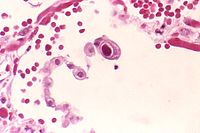
Photo from wikipedia
Background We previously reported that after completion of 3 months of prophylactic treatment with valganciclovir in cytomegalovirus (CMV) donor positive, recipient negative (D+/R-) heart transplant patients, there was a high… Click to show full abstract
Background We previously reported that after completion of 3 months of prophylactic treatment with valganciclovir in cytomegalovirus (CMV) donor positive, recipient negative (D+/R-) heart transplant patients, there was a high incidence of CMV disease, with six out of seven recipients (86%) developing CMV disease within the next 6 months. A novel, three-tiered CMV prophylactic strategy for D+/R-heart transplant recipients was thus implemented at our center in 2010. The efficacy of this strategy is unknown. Methods We retrospectively reviewed consecutive heart transplants between September 2010 and December 2013. The novel 3-tiered CMV protocol administered to D+/R- patients consisted of: 1) Renally-dosed valganciclovir, starting on post-operative day 5 and continuing for 12 months, if tolerated; 2) CMV Immune Globulin administration through 16 weeks; and 3) Azathioprine rather than mycophenolate mofetil for immunosuppression. The diagnosis of CMV disease, consisting either of the CMV syndrome or tissue-invasive CMV infection, was established according to American Society of Transplantation Guidelines for clinical CMV infection. Results Of seventy-five heart transplant recipients, 17 (23%) were CMV D+/R-. Three of the 17 died of non-CMV causes within the first year. Among the remaining 14 recipients, CMV disease occurred in the first year in 3 (21%) recipients. Following cessation of valganciclovir at one year, another 4 (29%) recipients developed CMV disease within the next 6 months. Conclusion CMV D+/R- heart transplant recipients appear to have a lower incidence of CMV disease in the first year using a novel prophylactic regimen as compared to a historical group at our program. CMV D+/R- patients remain at risk of developing CMV disease with valganciclovir discontinuation, even after a full year of prophylactic treatment. Figure 1
Journal Title: Journal of Cardiac Failure
Year Published: 2018
Link to full text (if available)
Share on Social Media: Sign Up to like & get
recommendations!